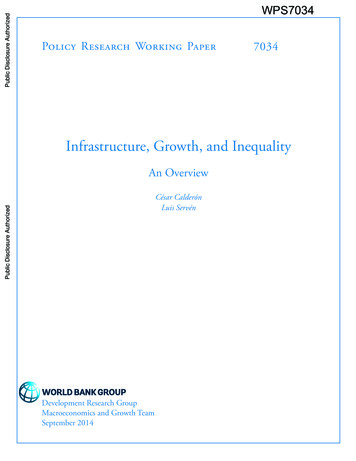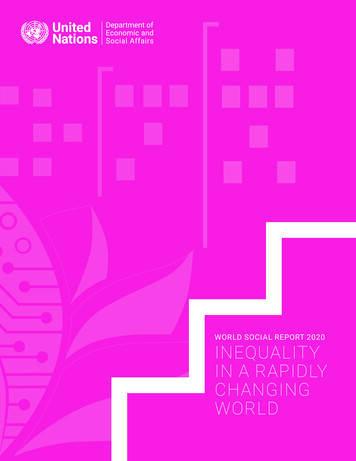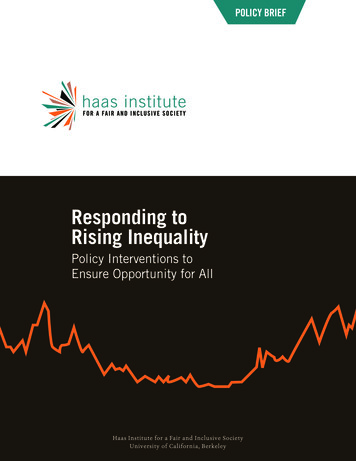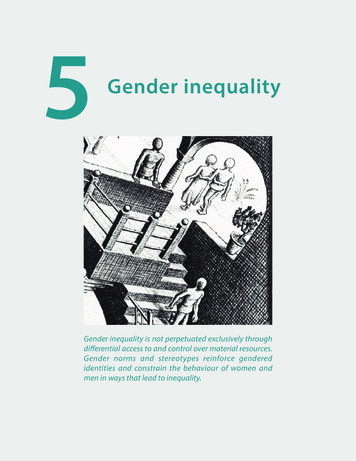
Transcription
Public Disclosure AuthorizedPolicy Research Working Paper7034Infrastructure, Growth, and InequalityAn OverviewCésar CalderónLuis ServénPublic Disclosure AuthorizedPublic Disclosure AuthorizedPublic Disclosure AuthorizedWPS7034Development Research GroupMacroeconomics and Growth TeamSeptember 2014
Policy Research Working Paper 7034AbstractAcademics and policy makers have long considered an adequate supply of infrastructure services to be essential foreconomic development. This paper reviews recent theoretical and empirical literature on the effects of infrastructuredevelopment on growth and income distribution. Thetheoretical literature has employed a variety of analyticalsettings regarding the drivers of income growth, the degreeto which infrastructure represents a public or a private good,and the extent of market distortions, notably in capitalmarkets. In turn, the empirical literature has used variouseconometric methodologies on time-series and cross-section macro and microeconomic data to test for the effectsof infrastructure development. However, these empiricaltests face challenging issues of measurement, identification,and heterogeneity. Overall, the literature finds positiveeffects of infrastructure development on income growthand, more tentatively, on distributive equity. Still, the precise mechanisms through which these effects accrue, andtheir full impact on welfare, remain relatively unexplored.This paper is a product of the Macroeconomics and Growth Team, Development Research Group. It is part of a largereffort by the World Bank to provide open access to its research and make a contribution to development policy discussionsaround the world. Policy Research Working Papers are also posted on the Web at http://econ.worldbank.org. The authorsmay be contacted at lserven@worldbank.org.The Policy Research Working Paper Series disseminates the findings of work in progress to encourage the exchange of ideas about developmentissues. An objective of the series is to get the findings out quickly, even if the presentations are less than fully polished. The papers carry thenames of the authors and should be cited accordingly. The findings, interpretations, and conclusions expressed in this paper are entirely thoseof the authors. They do not necessarily represent the views of the International Bank for Reconstruction and Development/World Bank andits affiliated organizations, or those of the Executive Directors of the World Bank or the governments they represent.Produced by the Research Support Team
Infrastructure, Growth, and Inequality: An OverviewCésar CalderónLuis ServénThe World BankJEL classification codes: H54, O40, D31Keywords: Infrastructure, public investment, growth, poverty, inequalityParts of this paper were prepared for the New Palgrave Dictionary of Economics. We thank JonTemple for useful comments and suggestions.
1. IntroductionAn adequate supply of infrastructure services has long been considered essential for economicdevelopment by both academics and policymakers. The role of transport infrastructure, forinstance, in fostering economic prosperity goes back to Adam Smith’s Wealth of Nations, whichlisted “the duty of erecting and maintaining certain public works” among the three coreobligations of the sovereign.Over the last quarter century, research has devoted considerable attention to the contribution ofinfrastructure development to the growth of productivity and aggregate income. A vast literaturehas explored a multitude of theoretical scenarios characterizing the economic role of productivepublic services and their financing, and has examined the empirical evidence on the growthimpact of infrastructure development in a variety of cross-section, time-series and panel datasettings.In addition to its impact on aggregate income, infrastructure can also have an impact on incomeinequality, and this issue has attracted increasing theoretical and empirical attention in recentyears. Conceptually, there are good reasons why infrastructure development may have adifferential effect on the incomes of the poor, over and above its impact on aggregate income.Infrastructure facilitates the poor’s access to productive opportunities, raising the value of theirassets. It can also improve their health and education outcomes, thus enhancing their ctureservices—includingtelecommunications, electricity, roads, safe water and sanitation— play a key role in theintegration of individuals and households into social and economic life (World Bank 2003).If infrastructure helps both raise income levels and reduce income inequality, its developmentcould offer a powerful tool for poverty reduction. Partly for this reason, infrastructuredevelopment has become a policy priority in many countries. In fact, infrastructure absorbed amajor share of the fiscal stimulus deployed in the wake of the 2007–08 global crisis: on average,emerging and developing economies devoted 40 percent of the stimulus to infrastructurespending, while advanced economies devoted 21 percent (International Labor Organization2011).This paper reviews recent theoretical and empirical literature on the effects of infrastructuredevelopment on growth and income distribution, with particular emphasis on developing2
countries. Because the literature has grown massively over the last two decades, the review isnecessarily selective rather than exhaustive. It also leaves aside the effects of infrastructure onother dimensions of the development process, as well as the political economy and other factorsunderlying infrastructure policies.The rest of the paper is organized as follows. Section 2 reviews the literature on the growtheffects of infrastructure while Section 3 deals with its effects on income distribution. Section 4highlights key challenges faced by the empirical literature on both topics. Finally, Section 5offers some closing remarks.2. Infrastructure and growthStarting with the work of Aschauer (1989), a vast analytical and empirical literature has beenconcerned with the effects of infrastructure development on income growth, productivity andwelfare. Below is a summary view; more comprehensive accounts can be found in Irmen andKuehnel (2009) and Romp and De Haan (2007).2.1 Analytical approachesMuch of the relevant literature examines the growth effects of public investment rather thaninfrastructure. But the two concepts may differ, for two reasons. First, in many countries thegovernment’s involvement in productive activities is not limited to infrastructure. Second, whilethe public sector has traditionally played the leading role in the provision of infrastructure,private sector participation has been on the rise across the world.Following the seminal work of Arrow and Kurz (1970), the output impact of infrastructure hasbeen modeled by including either the stock of infrastructure assets or the flow of infrastructureservices as an additional input in the economy’s aggregate production function, and furtherassuming that infrastructure is a gross complement for non-infrastructure inputs -- labor and noninfrastructure capital. In this framework, an increase in the volume of infrastructure servicesraises output not only directly, but also indirectly, by ‘crowding-in’ other inputs owing to theaccompanying rise in their marginal productivity. This indirect effect may take placeinstantaneously (for variable inputs in elastic supply) or over time (for fixed inputs such ashuman and non-infrastructure physical capital).3
However, the expansion of infrastructure needs to be financed, and this represents acountervailing force: increasing taxation to finance public infrastructure crowds out the use ofother inputs, which offsets partly or fully the crowding-in effect via productivity. This washighlighted by Barro (1990) in an endogenous growth framework in which the government’scontribution to current output is captured by the flow of productive public expenditure (ratherthan the stock of public capital) financed through proportional income taxation. The welfaremaximizing level of productive expenditure is shown to be the same as that which maximizes theeconomy’s growth rate, and it is achieved when the share of productive government expenditurein GDP (and hence the tax rate) equals the elasticity of aggregate output with respect to the samevariable – what is often called the ‘Barro rule.’ If productive expenditure exceeds this level, theadditional distortionary taxation needed to finance it diverts non-infrastructure investment awayto the point that income growth is reduced. 1Many of the theoretical contributions after Barro (1990) use an endogenous growth frameworkallowing infrastructure to impact the economy’s long-run growth rate. In many cases, however,the focus is on the stock of infrastructure assets rather than the flow of infrastructure-relatedexpenditure. The underlying logic is that, while the flow-based approach offers the importantadvantage of analytical tractability, the availability of infrastructure services (e.g., road transport)often relates more closely to the stock of infrastructure assets (e.g., the stock of public highways)than to the flow of expenditure on infrastructure-related activities (e.g., annual spending on roadconstruction). 2Following this logic, Futagami, Morita and Shibata (1993) extended Barro’s (1990) model toinclude both public and private capital, with the rate of public investment as the government’skey decision variable. This framework yields some new results. On the one hand, the economydisplays nontrivial transitional dynamics. On the other, the growth-maximizing level of publicinvestment (as share of output) is still equal to the elasticity of output with respect to publiccapital; however, its welfare-maximizing level is lower. Intuitively, public investment takes time1Similar results apply in broader settings; for instance, Fisher and Turnovsky (1998) show that, in the Ramsey-typeframework of Arrow and Kurz (1970) and with a Cobb-Douglas technology, an increase in the stock of publicinfrastructure raises the private capital stock only if infrastructure spending is below the level defined by the Barrorule. With more general technologies, the elasticity of substitution between infrastructure and other capital alsocomes into play; on this see Eden and Kraay (2014).2Indeed, Aschauer’s (1989) pioneering empirical analysis was framed in terms of the productivity of the publiccapital stock.4
to become productive, and this delay entails an additional sacrifice of current consumption forfuture consumption.In reality, infrastructure provision requires both capital and recurrent expenditure; e.g. to buildand maintain roads, respectively. Tsoukis and Miller (2003) and Ghosh and Roy (2004) examinehow the above results are affected when the stock of public capital and the flow of noninvestment spending are considered simultaneously. Overall, the earlier results stand: the welfareand growth-maximizing levels of recurrent expenditure coincide, but they differ in the case ofinvestment expenditure, for which growth maximization implies public investment in excess ofthe welfare-maximizing level.Modeling infrastructure just like another input in production is a natural way to captureproducers’ direct use of electricity or transport services. But infrastructure may also enter theproduction function as a determinant of aggregate TFP, i.e. an ‘unpaid factor’ with spillovereffects on the productivity of other inputs (Hulten and Schwab 2000). 3 For example, Bougheas,Demetriades and Mamuneas (2000) and Agenor (2013) argue that transport andtelecommunications services facilitate innovation and technological upgrading by reducing thefixed cost of producing new varieties of intermediate inputs. In a Romer-style framework, thisraises output growth.Aside from its role in the production function, another strand of the literature highlights the roleof infrastructure in the accumulation of other inputs. For example, better transport networks mayreduce installation costs of new capital (Turnovsky 1996). Likewise, improved access toelectricity may raise educational attainment and reduce the cost of human capital accumulation(Agenor 2011). In these cases, the growth-maximizing output share of infrastructure spending isnot given just by the elasticity of output with respect to infrastructure capital: one must alsoaccount for the output effect accruing through the accumulation of other inputs, and this tends tomake the growth-maximizing rate of infrastructure provision (as well as its welfare-maximizinglevel) higher than when the latter effect is absent.Contrary to what much of the literature assumes, few infrastructure services are pure publicgoods. In particular, congestion tends to make most services rival; think of road transportation,3While the distinction between both scenarios is conceptually clear-cut, it is blurred in empirical applications usingCobb-Douglas technologies, which confound both effects.5
for example. Further, many services–such as power and telecommunications, or even tollroads— are excludable, and thus suitable for financing through user fees (and for privateprovision). 4The literature has considered two forms of infrastructure congestion. Under absolute congestion,services received by an individual user depend negatively on aggregate usage. Under relativecongestion, they depend positively on the individual’s usage relative to aggregate usage.Analytical details vary depending on the chosen option as well as the production technology(Barro and Sala-i-Martin 1992, Eicher and Turnovsky 2000). Nevertheless, some basic resultsfrom the models without congestion continue to hold. For example, in an endogenous-growthsetting with infrastructure modeled as a service flow, the welfare-maximizing level of publicinfrastructure spending is still dictated by the Barro rule. If infrastructure is viewed instead as astock, such rule leads to excessive accumulation, just like in the absence of congestion(Turnovsky 1997). However, in an exogenous growth setting, the crowding-in effect ofinfrastructure on non-infrastructure capital tends to be diminished, or even reversed, especiallywhen the financing is done through distortionary taxes (Fisher and Turnovsky 1998).Another important feature of infrastructure is the presence of network effects, which can lead tostrong nonlinearities in its marginal productivity. For example, road construction may havelimited effects until the road network is minimally developed, at which point the marginal outputcontribution of additional roads may rise sharply. Once the entire network has been completed,however, additional road building is likely to have rapidly declining output effects (see Fernald1999). Under appropriate conditions, these nonlinearities may lead to multiple equilibria and toan enhanced role of infrastructure development policy: with a poor infrastructure endowment,the marginal productivity of infrastructure is low, and only a low-growth equilibrium may beattainable by the economy; however, a sufficient expansion of infrastructure networks wouldraise the productivity of infrastructure and permit reaching the high-growth equilibrium (Agenor2013).2.2 Empirical studies4Ott and Turnovsky (2006) examine the implications of congestion and excludability for the optimal financing ofinfrastructure services in a macroeconomic setting. Absent excludability, distortionary taxation reduces overutilization of infrastructure and thus congestion. With full excludability, user fees provide the optimal form ofinfrastructure financing.6
Few in academic or policy circles would dispute the view that infrastructure development fostersgrowth, but there is little consensus on the actual size of the effect and the factors that shape it.The empirical literature concerned with this issue took off following Aschauer (1989), whofound that the stock of public infrastructure capital is a significant determinant of U.S. aggregateTFP. However, his estimates of the elasticity of output with respect to infrastructure wereimplausibly large (around 0.40), owing to a ‘spurious regression’ problem (see Gramlich 1994).The massive empirical literature that followed focused on the impact of infrastructure on thelevel and growth rate of aggregate output or productivity, with numerous papers employing alarge variety of data and empirical methodologies. Many authors estimated the elasticity of GDPwith respect to infrastructure in an aggregate production function setting, using national orsubnational data and time-series or panel techniques suitable for dealing with nonstationaryvariables and spillover effects. Early applications to panel data on U.S. states found muchsmaller elasticities than those estimated by Aschauer (e.g., Holtz-Eakin 1994; Baltagi and Pinnoi1995). Drawing from a large number of subsequent empirical studies using aggregate data,primarily from industrial countries, a meta-regression analysis of the elasticity of output withrespect to public capital yields an average estimate around .10, although the individual estimatesfrom the underlying studies vary widely, from -1.73 to 2.04 (Bom and Ligthart 2014).These studies use monetary measures of public capital, constructed by accumulating investmentflows. Alternatively, others employ physical measures of infrastructure assets encompassingmultiple infrastructure sectors — sometimes aggregated into a synthetic indicator. Empiricalstudies using the latter approach on cross-country panel data typically report a significant GDP(or productivity) contribution of infrastructure; see Canning (1999), Calderón and Servén (2003)and Calderón, Moral-Benito and Servén (2014). 5In the Cobb-Douglas framework used by many of these papers, it is not possible to assess theextent to which the effects of infrastructure reflect its TFP-augmenting role. This is the focus ofrelatively few studies. Hulten and Schwab (2000) use a growth decomposition approach toexamine the contribution of public capital to manufacturing TFP growth across U.S. states. Theyfail to find significant effects. Hulten, Bennathan and Srinivasan (2006) apply a similar approach5Regarding individual sectors, Roller and Waverman (2001) find a large output impact of telecommunicationsinfrastructure in industrial countries, while Fernald (1999) reports similar results for roads using industry-level datafor the U.S.7
to data from Indian states, using physical indicators of infrastructure assets in transport andpower, and find that infrastructure development accounted for almost half of the observed TFPgrowth. Duggal, Saltzman and Klein (1999) allow for nonlinear production technologies. Usingaggregate U.S. data, they find that public infrastructure capital is an important determinant ofTFP. Duggal, Saltzman and Klein (2007) extend the framework to include also privatelysupplied IT infrastructure, which contributes to production both as a standard input and as adriver of TFP. Both types of infrastructure are found to have a significant positive effect onproductivity.A related line of research, pioneered by Berndt and Hansson (1991), takes a dual approach andfocuses on the estimation of cost and/or profit functions augmented by either infrastructure orpublic capital stock measures. The empirical finding in most cases is that infrastructure reducesproduction costs or increases profits – see Demetriades and Mamuneas (2000) on OECD crosscountry data, and Cohen and Morrison Paul (2004) on U.S. state data.A different strand of literature evaluates the long-term growth impact of infrastructure, typicallyusing a reduced-form growth-regression framework relating long-run growth to suitableindicators of infrastructure, public capital or public investment, often in conjunction withstandard control variables from the empirical growth literature. Measures of infrastructure andconditioning variables differ across studies, so they are not easy to compare. However, thosepapers using monetary measures of public capital stocks or public investment yield mixed results– e.g. Holtz-Eakin and Schwartz (1995) and Crihfield and Panggabean (1995) find no significantgrowth effects of infrastructure across U.S. states and metropolitan areas. In turn, Easterly andRebelo (1993) find that public investment in transport and communications significantly raisesgrowth across countries. Devarajan et al. (1996) find a negative relationship between the share ofinfrastructure in total public expenditure and economic growth in panel data for developingcountries, while Gupta et al (2005) find the opposite result in a different cross-country panel dataset.In contrast, growth regressions using physical indicators of infrastructure stocks almostinvariably find significant growth effects. In many cases, they use the number of telephone linesto proxy for infrastructure (e.g. Easterly 2001). In others, they use synthetic indicators capturingphysical stocks in multiple infrastructure sectors – transport, power, and telecommunications.8
Sanchez-Robles (1998) and Calderón and Servén (2004, 2010a,b) find that these summarymeasures are positively and robustly related to per capita GDP growth in panel data setscombining industrial and developing countries. The magnitude of the effects is substantial: a 1percent increase in physical infrastructure stocks, given other variables, temporarily raises GDPgrowth by as much as 1-2 percentage points, although the growth acceleration gradually tapersoff as the economy approaches its long-run per capita income.The literature cited so far takes a country-level perspective. However, there are also studies thatexamine the effects of infrastructure development for income growth at a more disaggregatedlevel. For example, Rud (2012) investigates the impact of electricity provision on manufacturingoutput across Indian states. Electricity provision is not exogenously assigned, and to deal withthis problem the study takes advantage of the introduction of a new irrigation-intensiveagricultural technology, viewed as a natural experiment. Adoption of new varieties of high-yieldseeds required, among other things, timely irrigation, for which electric pumps were used. Thus,the initial availability of groundwater across states is employed to control for the endogeneity ofthe expansion of the electricity network. The evidence shows that, on average, a one-standarddeviation increase in the measure of electrification is associated with a 14 percent expansion instate manufacturing output.In turn, Datta (2012) examines the consequences of a major road improvement program in India-- the Golden Quadrilateral Program (GQP) -- for the performance of firms. The location of eachindividual firm relative to the upgraded highway provides firm-specific exogenous variation inthe degree to which the quality of the roads improved as a result of the GQP. The study findsthat firms located on the highways targeted by the program improved significantly theirinventory management and reduced their input costs by switching suppliers.The bulk of the empirical literature summarized here focuses on measuring the output (orproductivity) gains from infrastructure assets. Less attention has been paid to the cost ofacquiring and operating these assets. Yet comparison of (social) marginal costs and benefits isnecessary to determine whether infrastructure is under- or over-provided. 66To some extent, the reduced-form growth regressions mentioned in the text shed light on this issue, given that theirestimates of the impact of infrastructure allow for the adjustment of other production inputs as well as the changes infiscal parameters required to accommodate infrastructure shocks.9
Canning and Pedroni (2008) use a simple empirical model in the spirit of Barro (1990) tocompare physical infrastructure stocks with their growth-maximizing levels in a panel ofcountries. Their finding is that infrastructure is under-provided in some countries and overprovided in others, and the verdict shows no clear correlation with countries’ per capita income.On average, the level of infrastructure is ‘just about right’ from the point of view of growthmaximization, so there is no evidence of a generalized infrastructure shortage. Using a similarframework, Kamps (2005) likewise concludes that there is no shortage of public capital in EUcountries.In turn, Eden and Kraay (2014) assess public capital shortages in low-incomecountries, using a Ramsey-type framework that highlights the degree of substitutability betweenpublic and private capital. Their estimate of the marginal return on public capital exceeds theuser cost, given by the rate of depreciation plus the world real interest rate (thus implicitlyassuming non-distortionary taxation). They conclude that, on average, public capital is underprovided in their sample countries.3. Infrastructure and income inequalityThe preceding discussion refers to the effects of infrastructure on the economy’s average income.But does infrastructure also have an effect on the distribution of income -- specifically, throughits differential impact on the income of the poor? For example, if an enhanced infrastructurenetwork helps connect lower-income segments of the population to markets for their inputs andoutputs – by reducing transport and logistic costs to affordable levels -- their incomes may risemore than the average, as may the value of their assets (land or human capital).The theoretical literature on the linkages between infrastructure and inequality is not as vast asthat on infrastructure and growth. It has examined the distributional effects of infrastructuredevelopment under various assumptions about income distribution dynamics, economicdistortions – notably in capital markets – and infrastructure-driven externalities. Empiricalresearch has likewise employed a variety of approaches, from cross-country and time-seriesregressions using macroeconomic data, to micro-level studies assessing the impact ofinfrastructure-related interventions on the incomes of the poor, especially in rural areas.3.1 Analytical approaches10
Attempts to model the relationship between public investment and inequality are grounded onthe literature on wealth distribution dynamics in the presence of capital market imperfections —see Banerjee and Newman (1993), Galor and Zeira (1993) and Piketty (1997). In these models,wealth redistribution towards the poor or the middle class can improve productive efficiency(Aghion and Bolton 1992, 1997). Enhanced availability of productive services—such aseducation, health and infrastructure— to the general population may not only improve efficiencybut also help reduce inequality. In this vein, Ferreira (1995) builds a model with private-publiccapital complementarity in an environment with capital market imperfections. The governmentparticipates in the production of certain goods and services in which it has a comparativeadvantage (e.g., infrastructure, education and health), and only higher-income individuals canafford to purchase private alternatives to public services. In this context, expanding publicinfrastructure services reduces the inequality of opportunity among entrepreneurs, increases thereturn on investment, and raises entrepreneurial activity among the less-favored segments ofsociety.Building on this framework, more recent contributions model the joint dynamics of publicinvestment, growth and inequality in a general equilibrium setting with heterogeneous agentsthat differ in their initial endowments of private capital. In these models, a pure public good orservice (e.g., infrastructure) interacts with private capital in the production of other goods.Getachew (2010) presents a two-sector growth model with capital market imperfections in whichpublic capital not only contributes to the production of goods, but also promotes theaccumulation of private (human) capital. Like in earlier models, income inequality hindersgrowth. Increased provision of productive public services not only raises aggregate growth, butcan also influence the distribution of income (and thereby exert a further indirect impact ongrowth) if the services accrue heterogeneously across individual households. Specifically, greaterprovision of public infrastructure benefits the poor more than proportionally because of theirlesser access to private substitutes.Chatterjee and Turnovsky (2012) likewise examine the dual role of public capital as growthengine and determinant of inequality. In their setting, public capital affects both productivity andlabor-leisure choices. Greater public investment raises factor incomes through the productivitychannel, while also affecting relative factor returns and the distribution of income and welfarethrough the labor-leisure choice. However, the mode of financing public investment matters for11
factor income shares and income inequality. Numerical simulation of the model shows that anydistributional gains may be only temporary if public investment is financed through nondistortionary taxes. On the other hand, income distribution improves both in the short and longrun when public investment is financed by levies on capital.Another dimension of income inequality that may be affected by public infrastructuredevelopment is the skill premium. It is examined by Pi and Zhou (2012) using a static multisectoral model with skilled and unskilled labor, in which public infrastructure is an input in theproduction of the different goods. A greater supply of public infrastructure raises the marginalproductivity of both skilled and unskilled labor —and, hence, their respective remuneration. Theeffect on the skill premium depends on factor intensities: if the sector using unskilled labor isrelatively more intensive in public infrastructure services, there will be an outflow of capitalfro
Modeling infrastructure just like another input in production is a natural way to capture producers' direct use of electricity or transport services. But infrastructure may also enter the production function as a determinant of aggregate TFP, i.e. an 'unpaid factor' with spillover










